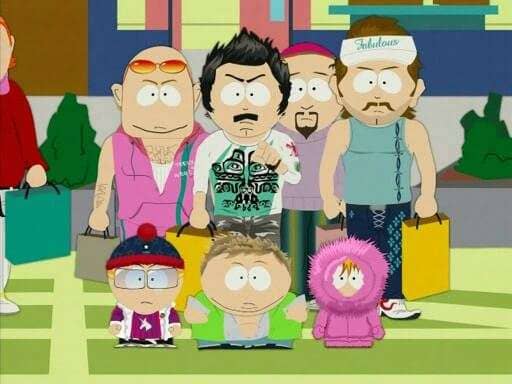By Mark Simpson
(Originally appeared in Out magazine, October 2017)
The US had a national nervous breakdown over male beauty in the early noughties.
It seems ridiculous now – and actually it was fairly ridiculous at the time – but it’s simply an objective fact that the US went completely fucking berserk over the metrosexual: my insufferably pretty offspring with the really great, hydrated skin. Not since the Beatles had a British import caused so much screaming – and so much moral panicking.
In 2003 – only a year or so after I’d introduced the him to the US in an essay for Salon.com that went virulently viral – ‘metrosexual’ was proclaimed ‘Word of the Year’ by The American Dialect Society. Handsomely beating SARS.
The same year, the networked animated cable TV series South Park devoted a whole episode to him satirising his stunning popularity, called ‘South Park Is Gay!’. In it all the straight men and boys in South Park turn, we are told, ‘metrosexual’ – which here seems to mean ‘effeminate’.
The ‘Fab Five’ swishy gay male grooming and lifestyle experts from Queer Eye For the Straight Guy – that year’s new, smash-hit makeover show – are blamed for the epidemic of preening. They turn out to be alien monsters and are executed by the men’s angry wives, who explain: ‘men need to be masculine!’.
Strangely, this disturbingly silly cartoon spoof pretty much predicted/incited how America ended up reacting in non-animated real life to the scary sexual ambiguity of metrosexuality.
The uptake of ‘gay’ beauty concerns by men along with the ‘feminine’ desire to be desirable, was something well underway by the noughties – without an intervention from the Fab Five (I’d originally written about metrosexuality for a British newspaper back in 1994, predicting the future of masculinity was moisturised).
In hindsight, I wonder how many of the straight men in NYC the Fab Five rescued from flaky skin, cheap chinos and TV dinners were just slumming it for the sake of a free facial, some product and plenty of attention.
For my money, Queer Eye For the Straight Guy, which was often described as the ‘metrosexual reality TV show’, had a typo in the title. It should have been ‘Queer Eye OF the Straight Guy’. But then it wouldn’t have been commissioned.
Queer Eye was entertaining, mostly safe fun precisely because it restated the already blurring boundaries in a reassuring way: straight men were hopeless at appreciating male beauty and gay men were fabulous. The queer eye belonged to the queers. Despite this, Queer Eye still managed to outrage some at the time – including apparently the makers of South Park.
My own definition of the metrosexual from my Salon essay had though been carefully inflammatory about the sexual ambiguity of the metrosexual:
‘He might be officially gay, straight or bisexual, but this is utterly immaterial because he has clearly taken himself as his own love object and pleasure as his sexual preference.’
Though of course the US marketers who tried to appropriate – and spay – the metrosexual after my essay went viral, vehemently insisted that the metrosexual was always straight. And never vain. Just ‘well-groomed’. No one really bought this. His ambiguity and out-and-proud vanity was the only reason anyone was interested in him.
And it’s also why America, which really wasn’t ready to face up to this stuff back then, ended up having a full-blown backlash against metrosexuality by 2006, when the full, horrifying implications of metrosexuality began to sink in. Anti-metrosexuality became the 21st Century ‘Disco Sucks!’ campaign, but with even more pronounced gay panic.
The US media now aroused itself talking up hilariously butch reaction-formations such as ‘machosexuals’, ‘retrosexuals’ and a ‘menaissance’. Lots of books with annoying, anal lists of ‘manly’ do’s and don’ts were published. Most of all, the MAN word was hysterically over-deployed, often as a reassuring manly phallic pacifier strapped on the front of something that so wasn’t: MANdates, MANscara etc.
Metrosexuality of course, along with hyper-consumerism and visual culture, continued conquering the world. But in the US it wasn’t polite to mention it: metrosexuality was now on the downlow. As the South Park wives had put it in 2003: Men need to be masculine!
Or at least we needed to pretend they need to be.
All of which was of course way camper than the metrosexual ever was.
Queer Eye itself was axed in 2007 – the same year that the legendary cable TV drama series Mad Men first aired. But the star of the show, and the apple of the camera’s eye, the very dapper Don Draper (John Hamm) was essentially a late noughties metrosexual daydream of what a 1960s retrosexual looked like.
Either way, he certainly didn’t need the Fab Five to pick out his shirts.

